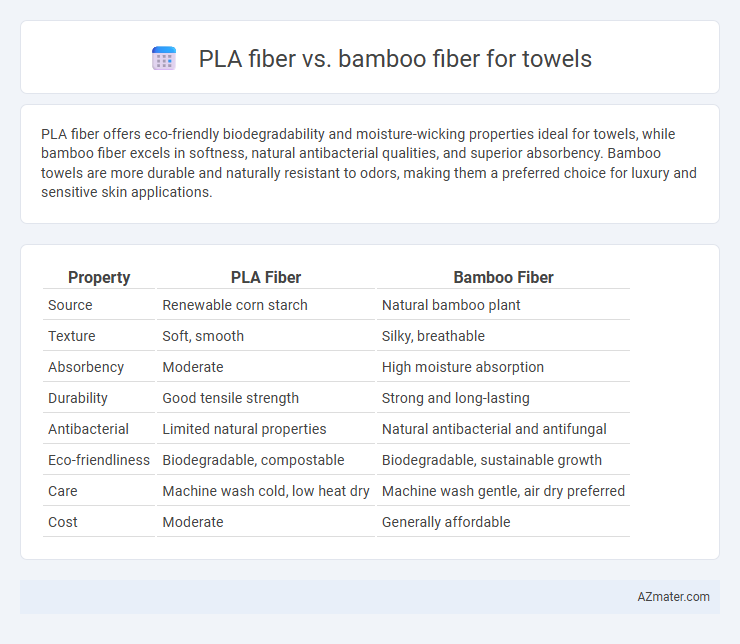PLA fiber offers eco-friendly biodegradability and moisture-wicking properties ideal for towels, while bamboo fiber excels in softness, natural antibacterial qualities, and superior absorbency. Bamboo towels are more durable and naturally resistant to odors, making them a preferred choice for luxury and sensitive skin applications.
Table of Comparison
| Property | PLA Fiber | Bamboo Fiber |
|---|---|---|
| Source | Renewable corn starch | Natural bamboo plant |
| Texture | Soft, smooth | Silky, breathable |
| Absorbency | Moderate | High moisture absorption |
| Durability | Good tensile strength | Strong and long-lasting |
| Antibacterial | Limited natural properties | Natural antibacterial and antifungal |
| Eco-friendliness | Biodegradable, compostable | Biodegradable, sustainable growth |
| Care | Machine wash cold, low heat dry | Machine wash gentle, air dry preferred |
| Cost | Moderate | Generally affordable |
Introduction: PLA Fiber vs Bamboo Fiber for Towels
PLA fiber for towels offers eco-friendly benefits with its biodegradable and renewable nature derived from corn starch, ensuring softness and durability. Bamboo fiber, known for its natural antibacterial and moisture-wicking properties, provides enhanced comfort and odor resistance in towels. Comparing both, PLA excels in sustainability and resilience, while bamboo fiber stands out for breathability and antimicrobial qualities.
What is PLA Fiber?
PLA fiber, derived from polylactic acid produced through the fermentation of renewable resources like corn starch or sugarcane, offers a sustainable alternative to traditional fibers for towels. This biodegradable synthetic fiber exhibits excellent moisture-wicking properties, breathability, and resistance to bacteria, making it suitable for absorbent and hygienic towel applications. Compared to bamboo fiber, PLA fibers provide a more consistent texture and are often preferred for eco-friendly textiles due to their lower environmental impact during production.
What is Bamboo Fiber?
Bamboo fiber is a natural textile derived from the pulp of bamboo plants, renowned for its softness, breathability, and antimicrobial properties, making it ideal for towel fabric. Compared to PLA fiber, which is a biodegradable plastic made from renewable resources like corn starch, bamboo fiber offers better moisture absorption and durability. Its eco-friendly cultivation requires less water and pesticides, enhancing sustainability for towel production.
Comparison of Softness and Comfort
PLA fiber towels offer moderate softness with a smooth texture, but bamboo fiber towels are renowned for their superior softness, providing a silkier and more luxurious feel against the skin. Bamboo fibers have natural moisture-wicking and hypoallergenic properties, enhancing comfort by keeping the towel breathable and gentle for sensitive skin. In comparison, bamboo fiber towels outperform PLA fiber towels in terms of softness and overall comfort, making them a preferred choice for plush, cozy towels.
Absorbency and Drying Capabilities
PLA fiber offers moderate absorbency but tends to retain moisture longer, slowing drying times in towels. Bamboo fiber excels in absorbency, soaking up more water due to its natural micro-gaps, and dries quickly thanks to its breathable, moisture-wicking structure. Towels made from bamboo fiber provide superior moisture management and faster drying compared to those made from PLA fiber.
Durability and Longevity
PLA fiber towels offer moderate durability but tend to degrade faster with frequent washing due to their compostable nature, making them less ideal for long-term use. Bamboo fiber towels excel in durability and longevity, as their natural antimicrobial properties help maintain fabric integrity over time and resist wear from repeated laundering. Choosing bamboo fiber towels ensures superior resilience and extended usability compared to PLA fiber alternatives.
Eco-Friendliness and Sustainability
PLA fiber, derived from renewable resources like corn starch, offers biodegradability and a lower carbon footprint compared to conventional fibers, making it an eco-friendly option for towels. Bamboo fiber is highly sustainable due to bamboo's rapid growth and minimal need for pesticides or water, contributing to soil preservation and reduced environmental impact. Both fibers promote sustainability, but bamboo's natural antimicrobial properties and minimal resource requirements give it an edge in eco-friendly towel production.
Antibacterial and Hypoallergenic Properties
PLA fiber exhibits natural antibacterial properties due to its ability to inhibit bacterial growth, making it a suitable choice for towels in sensitive environments. Bamboo fiber is renowned for its strong antibacterial and hypoallergenic qualities, attributed to its inherent bio-agent called "bamboo kun," which effectively reduces microbes and prevents irritation. Towels made from bamboo fiber often provide superior moisture-wicking and skin-friendly benefits compared to PLA fiber, enhancing comfort for allergy-prone users.
Care and Maintenance Differences
PLA fiber towels require gentle washing in cold water to prevent fabric weakening and avoid high heat during drying to maintain fiber integrity. Bamboo fiber towels offer better durability with resistance to shrinkage and naturally antimicrobial properties, allowing for more flexible washing temperatures and less frequent laundering. Both fibers benefit from avoiding bleach and fabric softeners to preserve softness and absorbency, but bamboo fiber towels generally demand less meticulous care.
Cost and Market Availability
PLA fiber towels generally have higher production costs due to the complex manufacturing process of polylactic acid from cornstarch, resulting in limited market availability primarily in eco-conscious niche segments. Bamboo fiber towels benefit from a more established supply chain and lower raw material costs, making them widely available and competitively priced in both mass-market and specialty eco-friendly sectors. The cost-effectiveness and broader distribution of bamboo fiber towels contribute to their larger market presence compared to the comparatively scarce and pricier PLA fiber alternatives.

Infographic: PLA fiber vs Bamboo fiber for Towel
 azmater.com
azmater.com